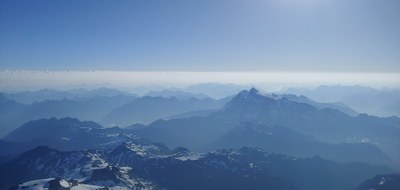
Trip Report
Basic Glacier Climb - Mount Baker/Easton Glacier
Mentored basic alpine climb w/ approx. 50% of participants having this be their first Glacier climb
- Sun, Jul 9, 2023
- Basic Glacier Climb - Mount Baker/Easton Glacier
- Mount Baker/Easton Glacier
- Climbing
- Successful
-

- Road suitable for all vehicles
-
Road was clear all the way to the trailhead. The road was very dry and dusty. Potholes not too bad.
We did not hit consistent snow until "Low Camp" at approx. 5,364'. Snow was firm enough to walk on without flotation, despite the 61 degree days. Glacier melt was not too bad and we were able to easily cross the stream on the hike in w/ no issues. A little buggy near the trailhead and in the forest, but not bad, as long as you keep moving.
We met at the trailhead (elev ~ 3,298) at 8 AM and departed by 8:30 AM. It was already 61 degrees.
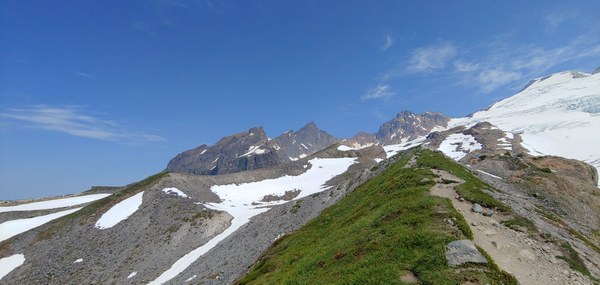
You can see from the image below, the trail up to Low Camp was clear of snow.
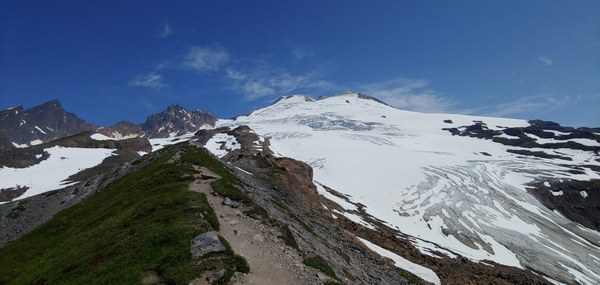
We made it to Sandy Camp (~6,417') by 1:15 PM. It was now 66 degrees.
Our trip plan included Low Camp as a "Plan C", Sandy Camp as "Plan B" and High Camp as "Plan A". The rationale being, that making High Camp on day 1 would put us that much further up the glacier and thereby making our summit push, that much shorter. Low camp ended up being quite populated.
Ran into several other Mountaineers members on the hike in. Shout out to Rob Busack and Scott Schissel.
As a group, we discussed the merits of making camp as Sandy Camp versus proceeding to High Camp. The group opted to remain at Sandy Camp, as there were easily 5+ great tent spots on the rock, snow nearby that wasn't too steep to dig out a tent spot, AND most importantly: a small flowing glacier melt stream. That saved us loads of time, effort, and fuel from having to melt snow for water. About 2/3 of our group opted to camp on rock with the balance on snow.
After pitching tents, we discussed our group plans for the next morning. Our initial intent was to start climbing at 3 AM, but due to the amount of people that we saw hiking in, at various camps, and coming down the mountain, we moved our start time up to 2 AM. This ended up being a great idea and put us ahead of the majority of the "Conga Line" heading up.
We put on crampons and roped up right at Sandy camp. This ended up saving us time and effort from having to stop somewhere on the glacier, likely on an exposed slope, to put those on, then do the same with the rope. Additionally, being roped up helped modulate the pace, as we had a variety of fitness levels, pace, and drives in our group. We laid out our ropes, harnesses, and gear the night before, so come Summit day, everyone just stepped into their positions with gear already laid out. Really helps reduce the anxiety in the morning when everyone is still in various stages of semi-consciousness or alertness. The entire team was ready to start the climb 10 minutes before schedule, so our preparations really paid off.
We began at 2 AM and made the summit at 7:15 AM. Pace was leisurely (just slightly faster than a rest-step pace), but moving. We stopped about every 50 or so minutes for approx. 10-15 minutes for layer adjustments, hydration/nutrition, and bio breaks. We hiked up the Easton Glacier route, which had a nice boot path. Snow was firm and stable. Crevasses were obvious, for the most part, and therefore relatively easy to navigate.
Once we made it up to about 9,680', just a few hundred feet up slope from where the Squak Glacier route meets Easton Glacier , there was quite a view of the crater:
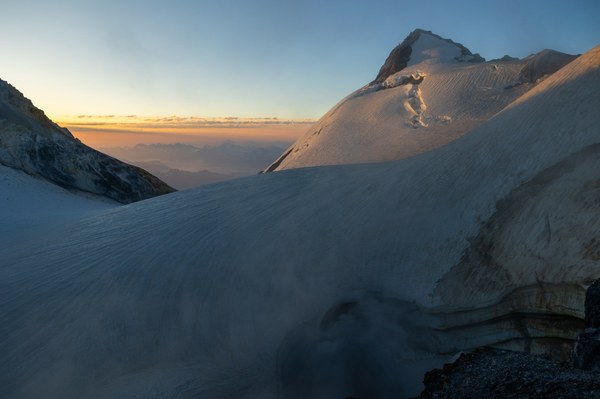
This is the last opportunity to have a semi-private and safe bio break. After this point, the slope increases dramatically with little to no safe or private spaces for the calls of nature, so keep this in mind!
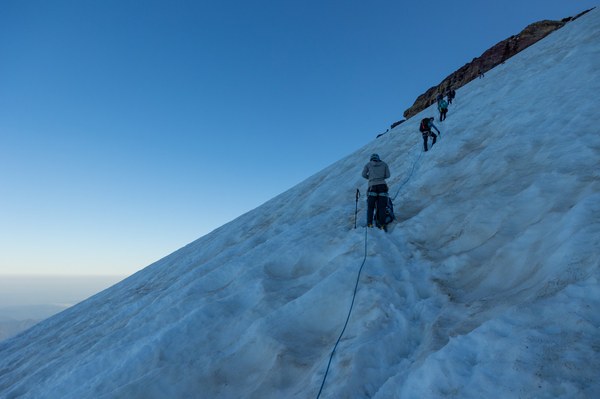
Once at the base of what I believe is called the Roman wall, we elected to stay left. The fresher boot-path went right with a more moderate ascent with switch-backs. The path to the left was shorter, but much steeper. In the end, this selection worked out better for us, as the snow was very consolidated with firm footing. Crampons and an ice ax were perfect. Also, since we knew this route from the ascent, it ended up being a better descent route, as by that time the previously mentioned route to the right was absolutely packed with teams making their way to the top. Additionally, since we were familiar with the terrain, having just climbed through it, there was little to no risk in proceeding down a route, with no idea of it's conditions, features, or hazards.
Once we made it to the false summit, we dropped and anchored our packs, then took the short (less than .25 mile) hike to the true summit.
Views from the top were spectacular!
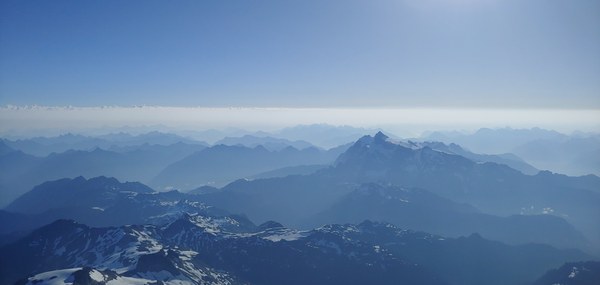
Hung out on the summit for about 20 minutes, signed the book, then headed back down to our gear drop. We roped up, then began our descent.
Returned to Sandy camp at 10:10 AM, departed Sandy camp at 11:30 AM. We arrived at the trailhead at approx. 1:30 PM, and were on the road by 2:10 PM.
Top take-aways:
1) Due to the heat, nearly everyone ran low on water on the hike in. There are running streams, so take advantage of them.
2) Additionally, due to the warmth of the day, almost 2/3 of the group suffered hot-spots and or blisters, including the author of this report. Bring extra socks and or blister care.
3) Camp options may be limited, so having tent stakes that work in hard packed dirt or snow, or simply one set of each is recommended.
4) This is a heavily traveled glacier. Start earlier than you might normally. Congestion going up as well as down can really throw a lot of risk and delays into your plans. We ran in to several groups that we passed, passed us, or we ran parallel for a time, going both up and down. For the most part, there is lots of room to work around groups, but there are some congestion points at crevasses and other features.
 Will Tooker
Will Tooker